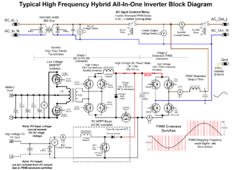You are using an out of date browser. It may not display this or other websites correctly.
You should upgrade or use an alternative browser.
You should upgrade or use an alternative browser.
Would this DIY surge protector work to protect MPPT charger?
- Thread starter fmeili1
- Start date
Here is DC coupled oscilloscope scan of PV- to ground of Growatt SPF-5000es. The arcs are superimposed 120Vac half cycles on PV- line commutated by low frequency IGBT halfbridge. Notice that switch ringing spikes down to -650V and that's what your MOV has to handle without conducting. I am not a fan of these AIO designs.


fmeili1
Solar Enthusiast
Do you know or do you think that this schema is valid for all typical high frequency AIO's like the EG4-6500EX (Voltronic clone but with 500Voc max. MPPT voltage)? I can't really check, if my 6500er does have this PV boost diodes. Maybe this diode is a must have for all these AIO's designs and I can eliminate the PV+ diode without checking it first?!Analyze this power circuit of typical hybrid AIO inverter and see if diodes make sense. Since there is already a boost diode on PV+ side maybe extra diode on that side can be eliminated. In that schematic blue N wire is actually L2 and is hot with 120V referenced to ground.
View attachment 201567
fmeili1
Solar Enthusiast
fmeili1
Solar Enthusiast
Ok, so I will design the PCB with just one schottky diode on the PV- side.Series diode has to be present in boost converter MPPT. Unless it's a design that steps solar down to 48V battery voltage first.
Ok I thought it was split phase inverter that runs on up to 500V DC bus. It looks like PV- will have -250V square wave with potential peaks into -400V from ringing. Would really have to measure it with a scope to be sure. You may be able to use lower voltage MOVs for better protection.
fmeili1
Solar Enthusiast
Ok, thanks for clarification. I'll try to check with a scope. I'll take a while to get a scope. Will keep you updated.Ok I thought it was split phase inverter that runs on up to 500V DC bus. It looks like PV- will have -250V square wave with potential peaks into -400V from ringing. Would really have to measure it with a scope to be sure. You may be able to use lower voltage MOVs for better protection.
fmeili1
Solar Enthusiast
Just double checked the forward voltage of high current schottky diodes vs standard diodes. I'm a bit confused, but it looks like that at higher current (at about 15A), a schottky diode has a higher forward voltage (between 2-3V) compared to standard diodes (about 1.2-1.5V)?! Only at low current, the forward voltage of schottky diodes seems to be lower.I like PCB idea. Just make sure diodes point in correct direction and place them on a heatsink. I am not sure if diodes will offer protection the way I imagine. I need to think about it more.
So for the design, a standard diode seems to be the better choice to reduce losses. For further reading I will post updates on the other thread which will cover surge protection, arc fault detection and ground fault protection for PV.
efficientPV
Solar Addict
- Joined
- Sep 24, 2019
- Messages
- 1,351
Why would you want to use a Schottky diode.
fmeili1
Solar Enthusiast
I thought I remembered that Schottky diodes has less forward voltages (beside higher speed) compared to standard diodes (e.g. 0.2V-03V instead of 0.7V). To reduce power loss and implement easier cooling, this was my first idea. But I've found, that the lower forward voltages of Schottky diodes are only true for low current in the mA range. At higher current like 10-20A, it's vice versa and the standard diode has lower forward voltage (2-3V compared to 1.2-1.5V).Why would you want to use a Schottky diode.
Last edited:
efficientPV
Solar Addict
- Joined
- Sep 24, 2019
- Messages
- 1,351
Schottky diodes typically have low forward voltages up to about 40V rated inverse voltage. Forward voltage is also lower when they run a bit toasty.
fmeili1
Solar Enthusiast
I only found view Schottky diodes with a high DC blocking voltage Vdc between 500V-600V. And these high voltage types have a lot higher forward voltage compared to low voltage Schottky diodes (at about the same current between 10A-20A). It looks like for PV switching the Schottky diodes are not ideal because of the high string voltage requirement. So I think, in this case classic diodes makes more sense and they are cheaper.Schottky diodes typically have low forward voltages up to about 40V rated inverse voltage. Forward voltage is also lower when they run a bit toasty.
fmeili1
Solar Enthusiast
Just want to let you know that I've done some further design of the PCB idea... see the corresponding thread.I like PCB idea.
Similar threads
- Replies
- 2
- Views
- 195
- Replies
- 16
- Views
- 732



